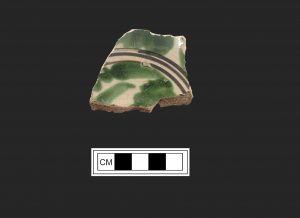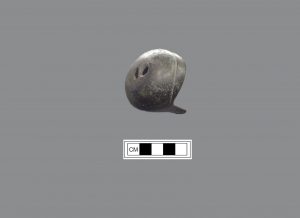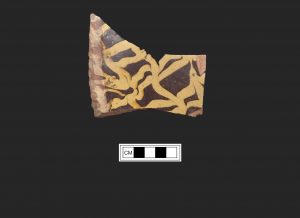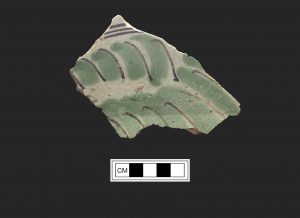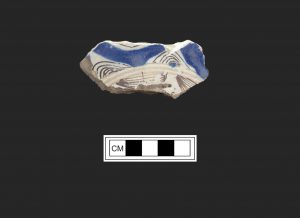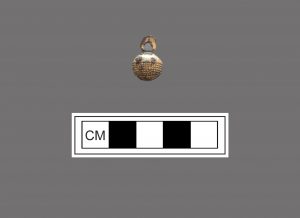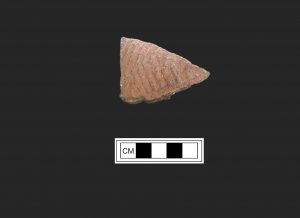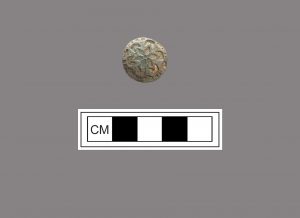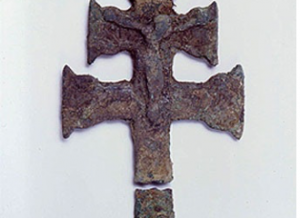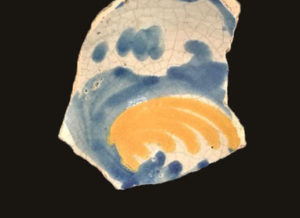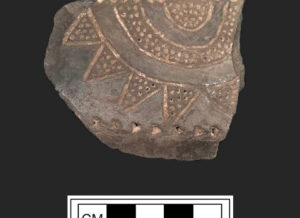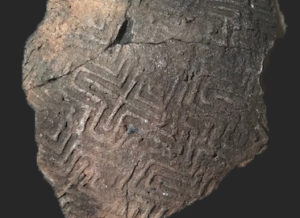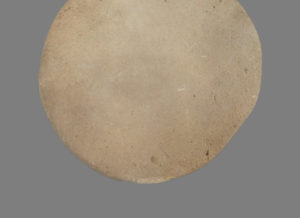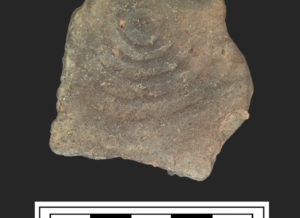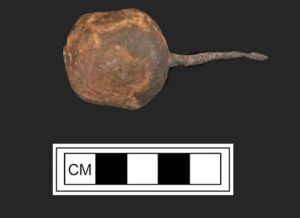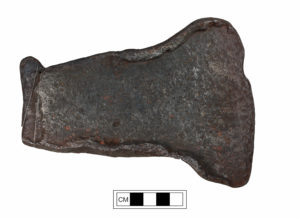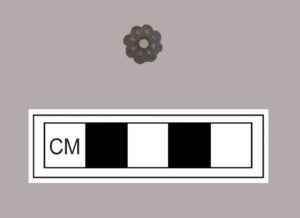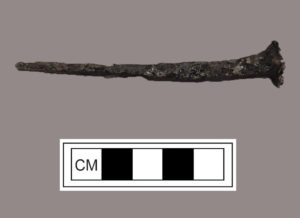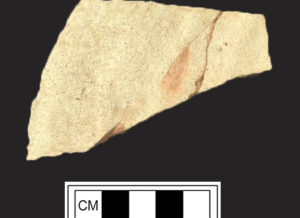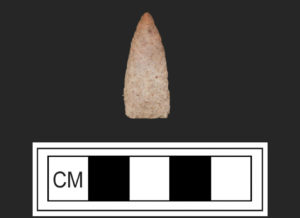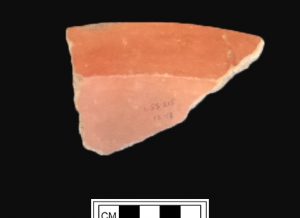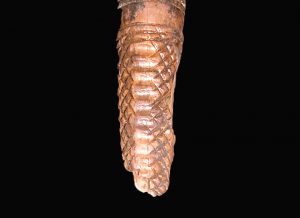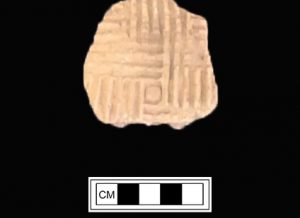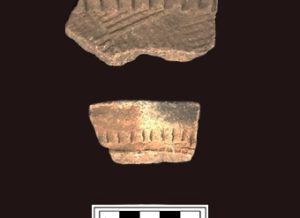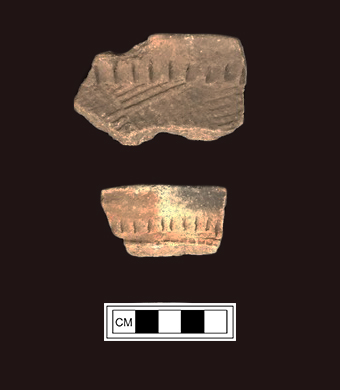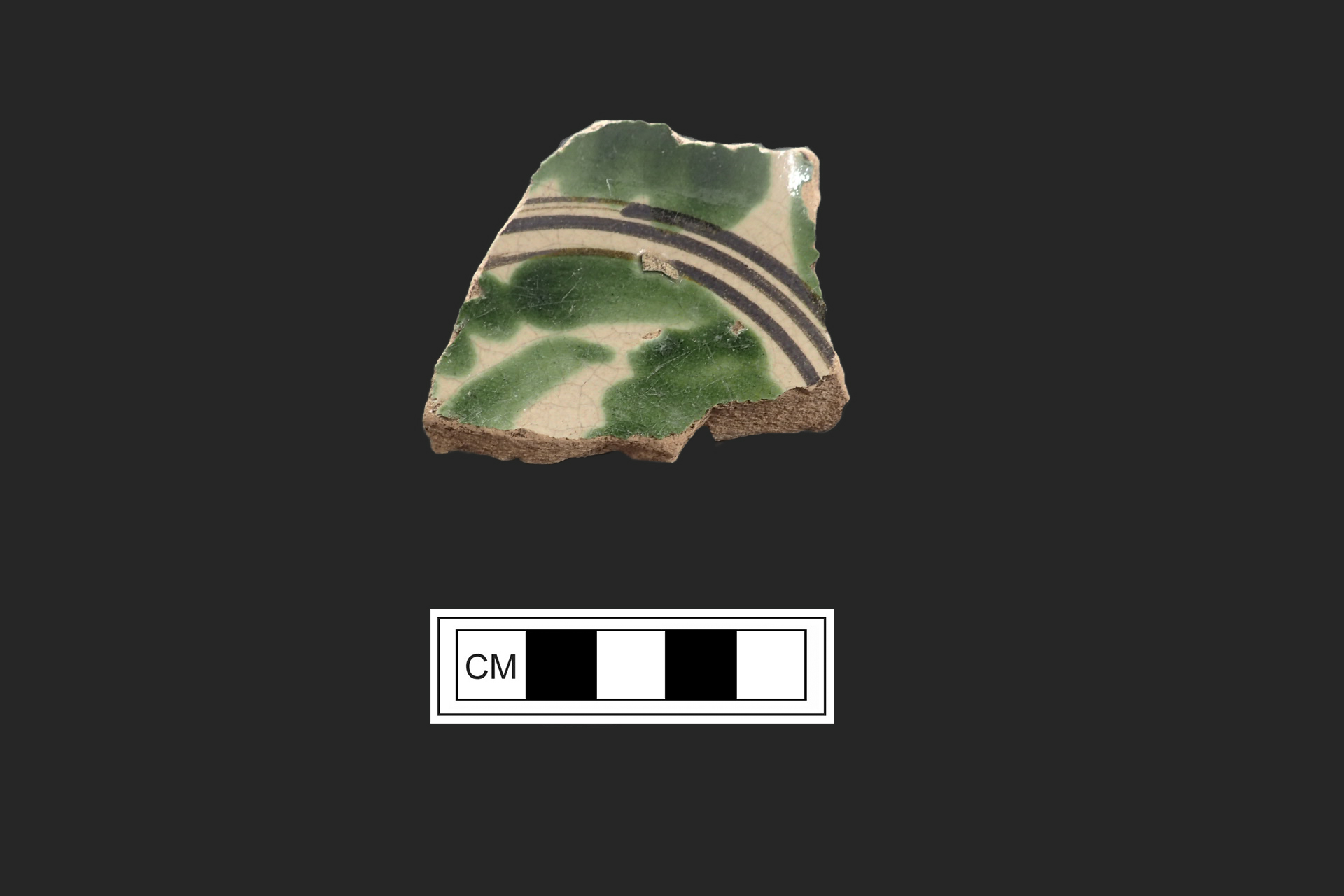
San Luis Polychrome
- Wheel thrown
- 1650-1750
- Mexico City
San Luis Polychrome, originally defined by John Goggin in 1968, is part of the Mexico City “Common Grade” majolica category, and incorporates a wide range of variation in quality and design motifs. It is related to both Mexico City Green on Cream and to Aucilla Polychrome, and has not been reported from pre-1650 contexts.

Brass buttcap from a pistol
- Cast or hammered
- Unknown, likely mid- to late- 17th century
- Unknown
Brass buttcap from a pistol. This gun part was found in the convento/hermitage complex at the Nombre de Dios site, and likely represents the 1702 British occupation at the site.
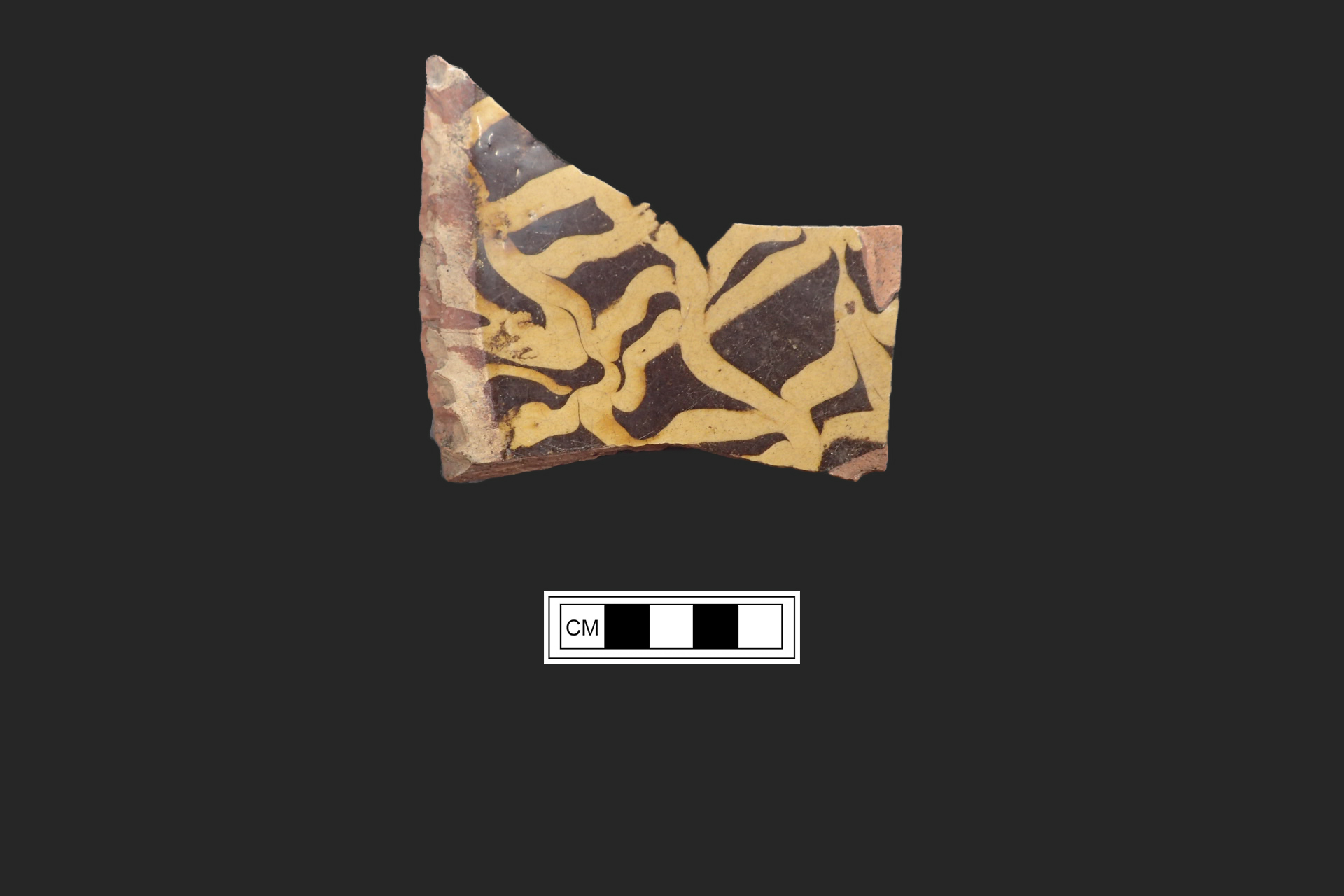
Staffordshire-type Slipware
- Wheel thrown or bat molded
- 1675-1770
- England
This yellow and brown slipware is associated with Staffordshire; however it was produced in several centers in England. It was made in a wide variety of both utilitarian and tableware forms.

San Luis Polyhcrome
- Wheel thrown
- 1650-1750
- Mexico City
San Luis Polychrome, originally defined by John Goggin in 1968, is part of the Mexico City “Common Grade” majolica category, and incorporates a wide range of variation in quality and design motifs. It is related to both Mexico City Green on Cream and to Aucilla Polychrome, and has not been reported from pre-1650 contexts.
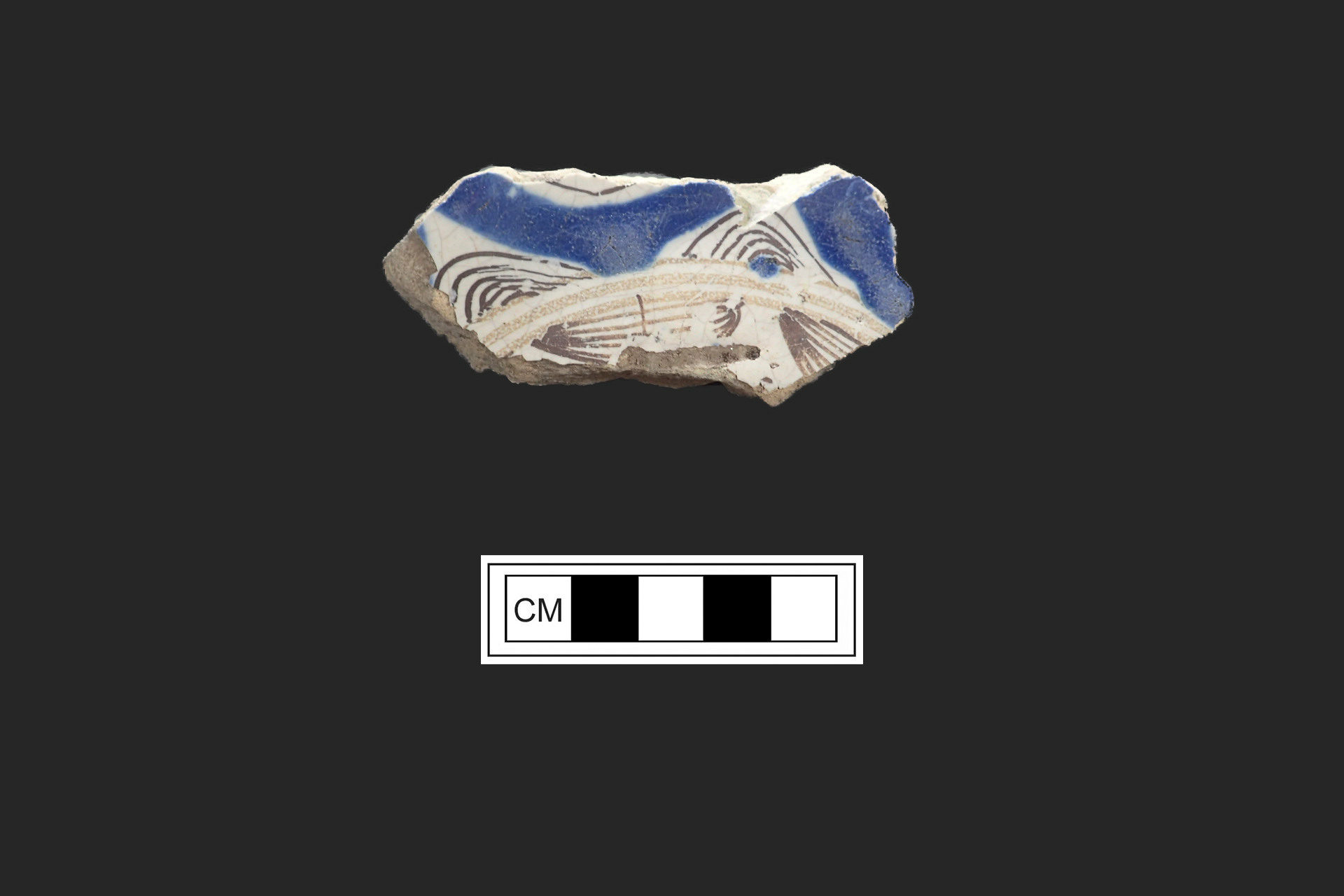
Puebla Polychrome
- Wheel thrown
- 1650-1725
- Puebla, Mexico
Puebla Polychrome majolica varies widely in the quality of its decoration, from sloppy to very fine and precise. The black line designs are thought to have been derived from Talaveran majolicas, which also exhibit lace-like patterns. Although blue is by far the most common color for decoration, emerald green, orange, and yellow paint are occasionally used. Background color is typically off-white or cream in color, however a few examples have a pale yellow background enamel.

Brass button
- Molded
- Unknown
- Unknown
Molded brass button recovered from Mission Nombre de Dios. It is likely that the button also had gold gilding which has since worn off.
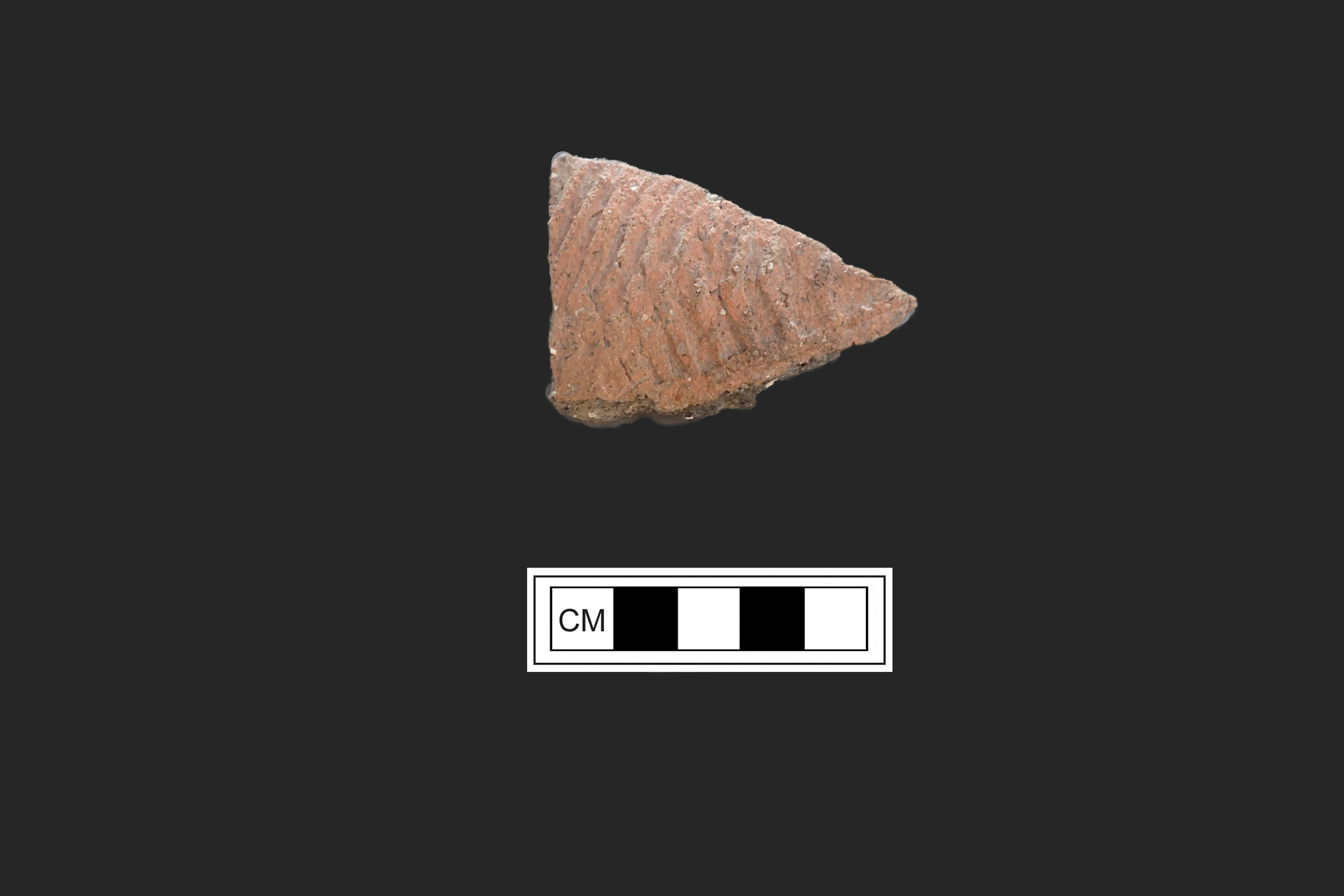
San Marcos Stamped
- Handbuilt coil
- Missions period, ca. 1587-1763
San Marcos Stamped ceramic sherd recovered from Mission Nombre de Dios.
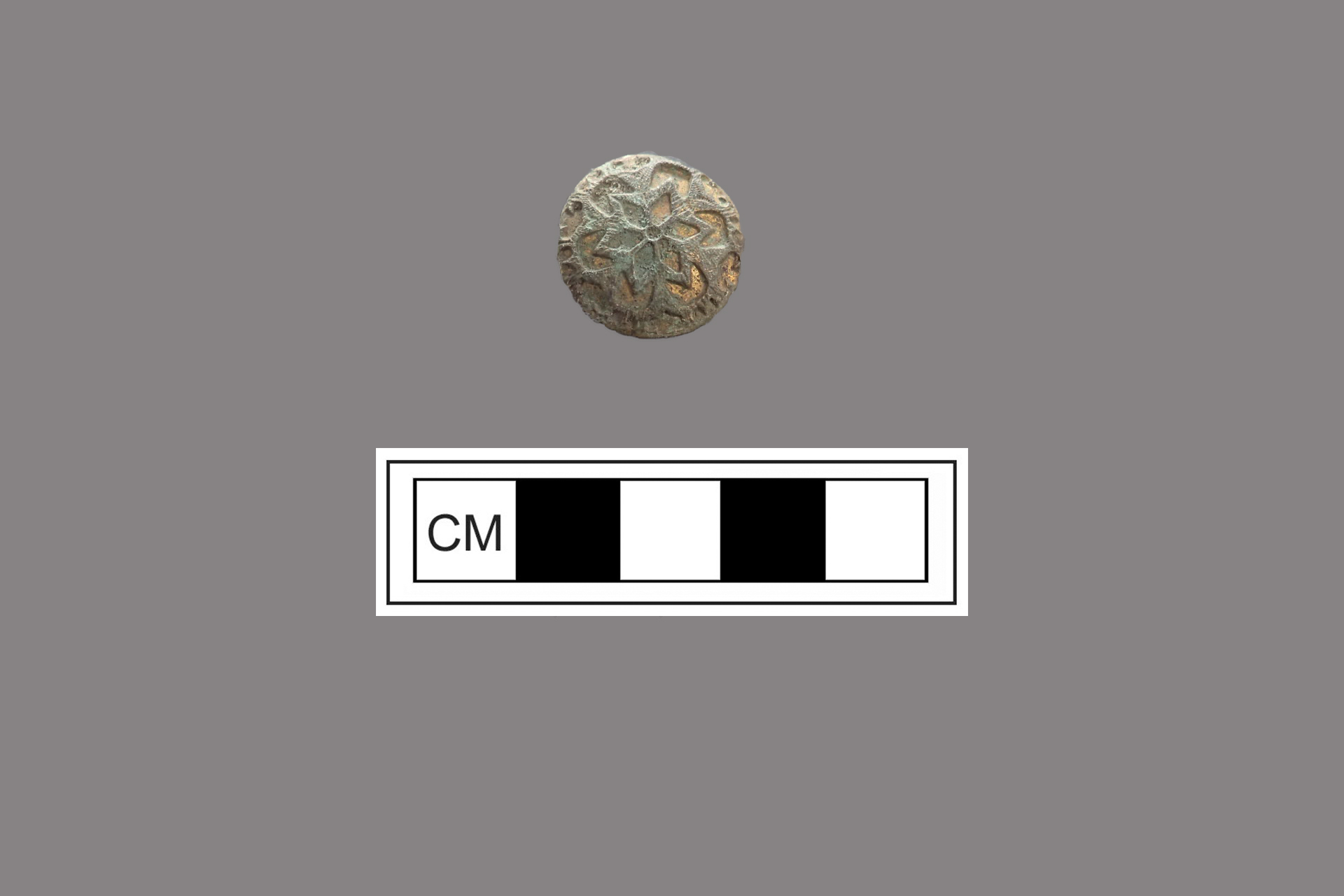
Orante brass button
- Molded
- Unknown
- Unknown
Ornate brass button recovered from Mission Nombre de Dios. It is possible that this button came from a British military uniform during the occupation of the site in 1702.
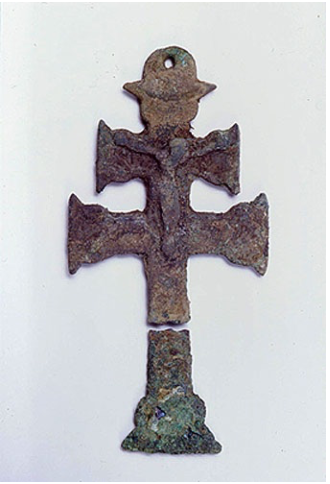
Caravaca cross
- 17th c.
- probably Spain
- 5.5cm in height
This photograph gallery contains images of artifacts typically found on mission sites in the Spanish colony of La Florida. Because the missions were largely populated by Native Americans, many of the objects reflect their traditional manufacturing and stylistic traditions. Items of European manufacture typically occur around the mission complex itself, since this is where the missionaries lived and worked. But it is not uncommon to find Native American objects in mission complex areas, or European objects in Native American villages. Missions seemed to be locations where peoples mixed traditions. This picture shows a 17th century Caravaca cross. This copper-alloy reliquary cross segment was found at the site of Mission Santa Catalina de Guale (8NA41) on Amelia Island, Florida (Cat#8NA41-2293). It may have been gifted to a Native American convert by a resident friar.
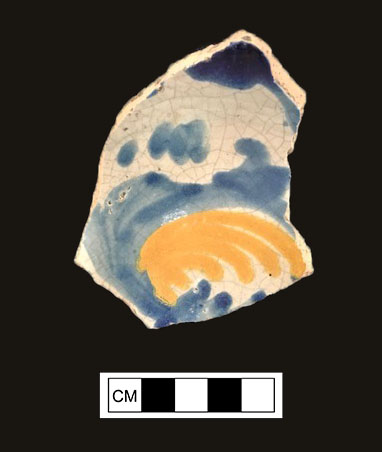
Fig Springs Polychrome Base/Footring
- Wheel thrown
- 1540-1650
- Mexico City
Fig Springs Polychrome, originally defined by John Goggin in 1968, is also know as “San Juan Polychrome.” It is one of the earliest American-made majolicas, and is part of the Mexico City “Fine Ware” majolica category, which came into production around 1540. It does not appear regularly in Florida or Caribbean contexts until after about 1575.
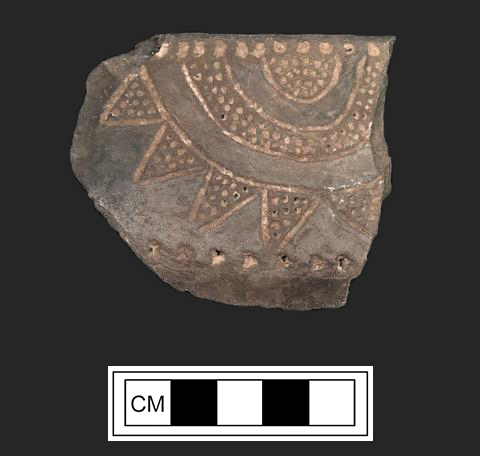
Fort Walton Incised Rim
- Handbuilt coil
- Middle Mississippian to early colonial, ca. 1300s to early 1600s.
This pottery type bridges the late pre-European contact to early colonial periods. It is characterized by bands, scrolls, and geometric motifs, often filled with punctations. Typical vessel forms include a variety of bowls, jars, beakers, and bottles. It is usually associated with the Florida panhandle region, but occurs elsewhere in Florida and Georgia as well as occasional finds in the wider Southeast.
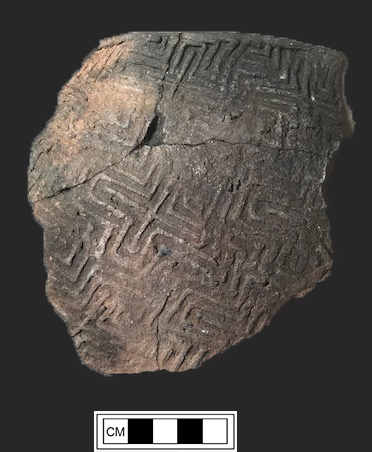
Jefferson Pottery Rim, Stamped-Cross Motif
- Handbuilt coil
- Late Mississippian to early colonial, 1300s to early 1600s
Jefferson wares appear to be a Florida variant of the Lamar type of pottery originally defined in central Georgia and the south Appalachian region. They are characterized by complicated stamped surfaces and occur in a variety of vessel forms. The stamp designs are boldly executed, and include motifs such as parallel lines, bulls-eyes, circles, triangles, and parallelograms. The cross design seen in this example seems to be unique to Florida missions.
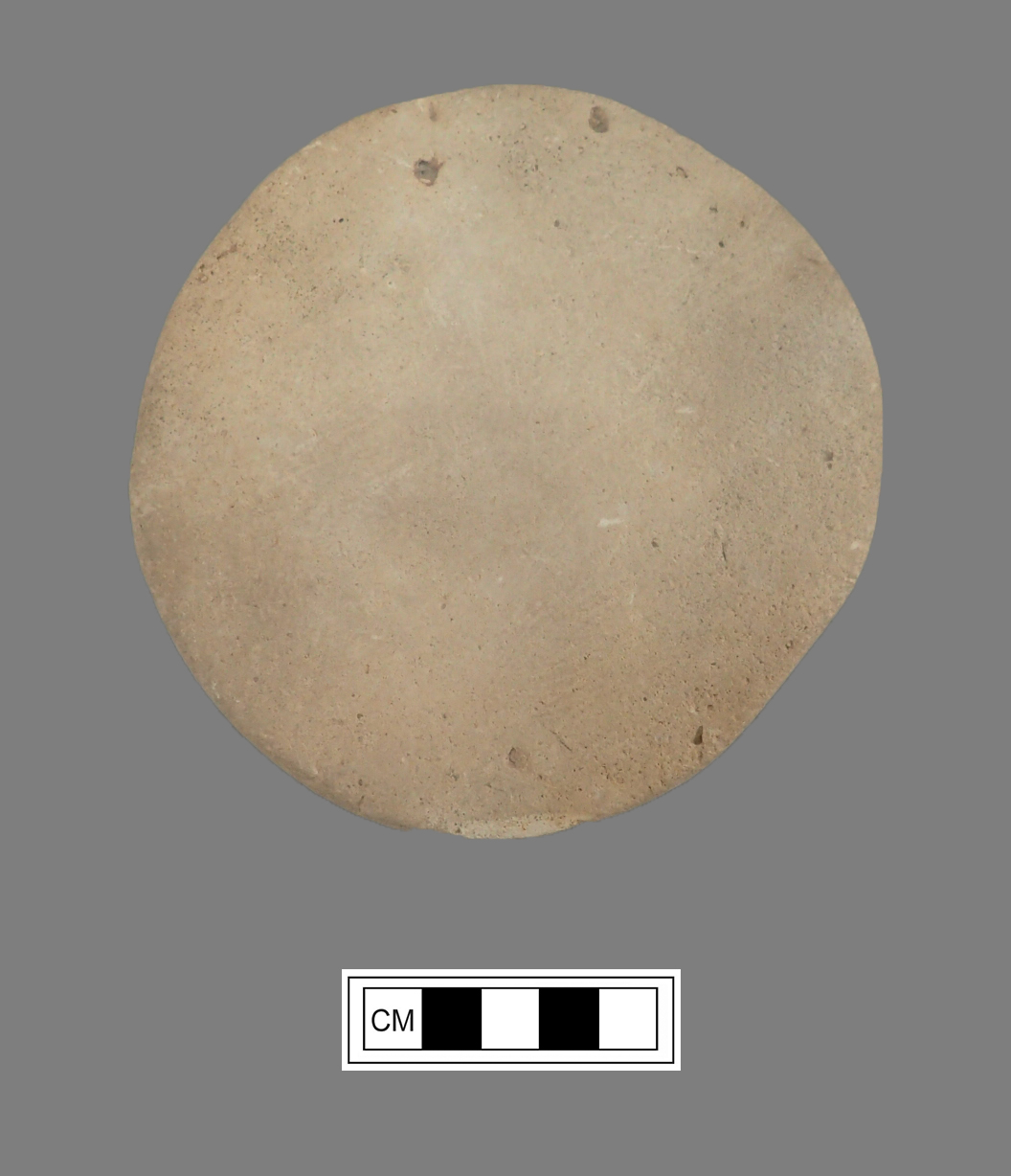
Groundstone disk, possible chunkey stone
- Ground
- Unknown
This carefully ground stone disc is possibly a chunkey stone, used in a game popular among Southeastern Indians. Our best description of the game comes from the Englishman James Adair (2005 [1775]:394) in the eighteenth century: “They have near their state house, a square piece of ground well cleaned, and fine sand is carefully strewed over it, when requisite, to promote a swifter motion to what they throw along the surface…one of them hurls the stone on its edge, in as direct a line as he can, a considerable distance toward the middle of the other end of the square: when they have ran a few yards, each darts his pole anointed with bear’s oil, with a proper force, as near as he can guess in proportion to the motion of the stone, that the end may lie close to the stone.”
Adair, James
2005 [1775] The History of the American Indians. The University of Alabama Press,Tuscaloosa.
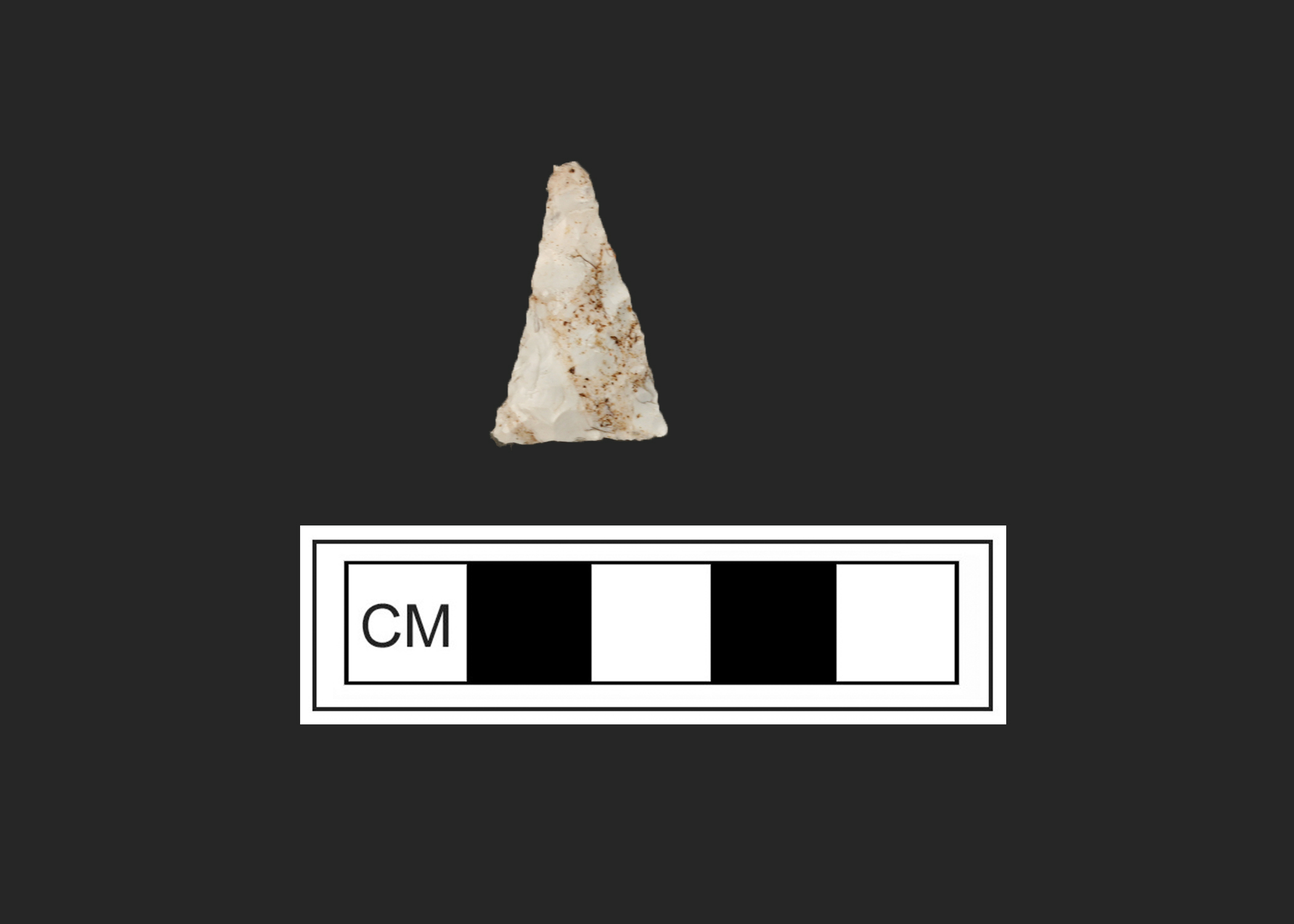
Pinellas Point
- Flaked stone
- Mississippian to Historic
These small, triangular points are believed to have been used to tip arrows. Triangular point traditions are common in the Mississippian (AD 1000-1500) to early colonial (1500-1600s) Native American cultures of southeastern North America, but they are distinguished by regional variations in shape and manufacturing techniques. The Pinellas Point, mainly found in central and northern Florida, often has relatively straight sides and the length is about twice the width.
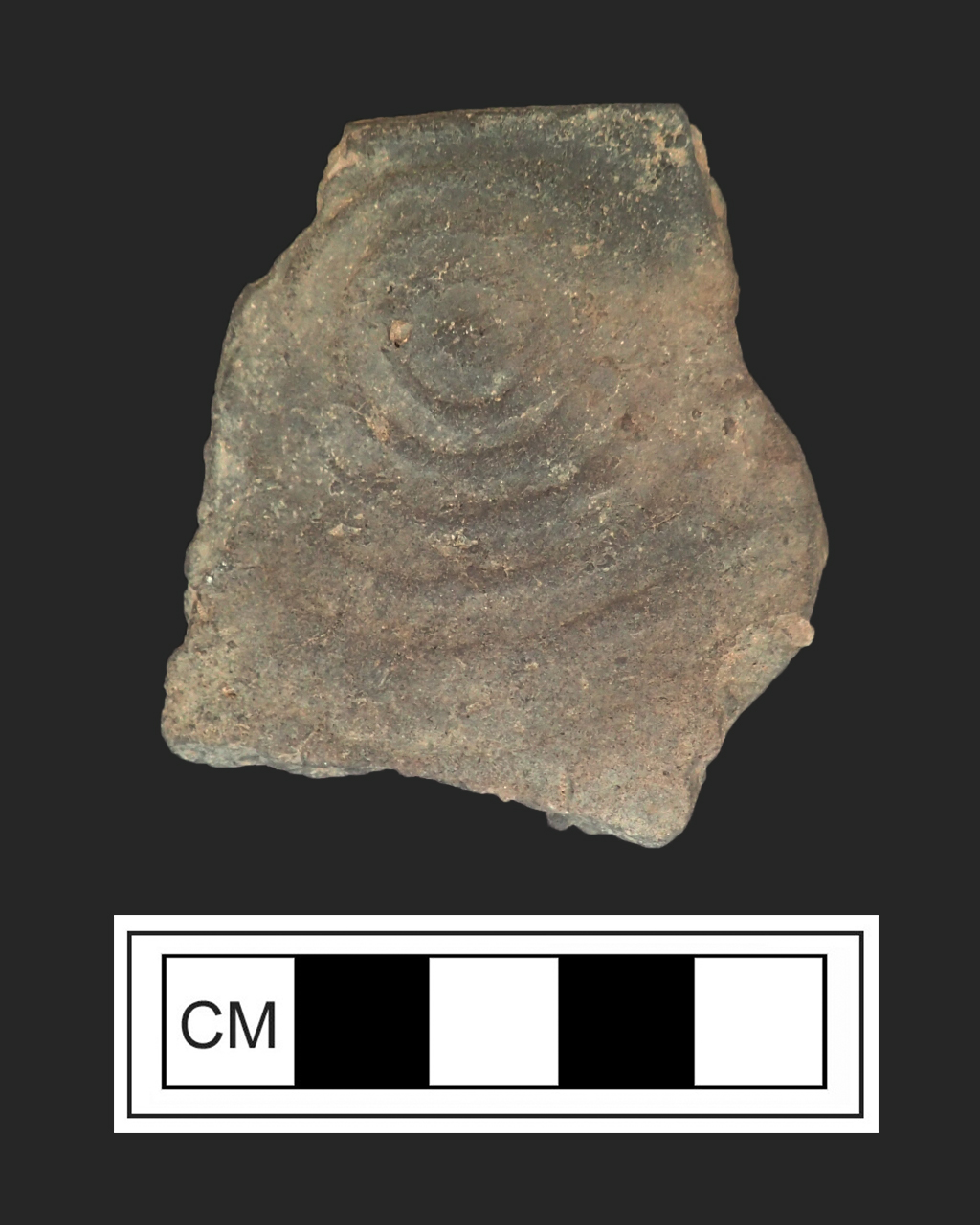
Jefferson Pottery Rim, Bull's Eye Stamped Motif
Jefferson wares appear to be a Florida variant of the Lamar type of pottery originally defined in central Georgia and the south Appalachian region. They are characterized by complicated stamped surfaces and occur in a variety of vessel forms. The stamp designs are boldly executed, and include motifs such as parallel lines, bulls-eyes, circles, triangles, and parallelograms. The concentric circle design in this example, a so-called bulls-eye, is one of the common motifs.

Prismatic Core
- Flaked stone
- Mississippian to Historic
One of the unusual traits of Florida stone tool technologies in the Mississippian to Historic periods is the occurrence of formal blades. These are stone flakes with parallel sides and with a length that is 2 or more times longer than the width. They are removed from carefully prepared prismatic stone cores, such as the depicted here. The flakes were removed in a rotating fashion from the top of core, which allowed for the removal of a large number of flakes from a modest sized stone nucleus. Blades have very sharp edges and are presumed to have been very useful as cutting tools. This technological tradition occurs in earlier time periods in North America, but was very rare at the time of the arrival of Europeans. Florida is one of the few examples of the persistence of this tradition.

Bell Clapper
- Cast or sheet metal
- 1400s to 1800s
A wide variety of European bells were introduced to the Americas, and they are among some of the earliest artifacts found on Native American sites in the 1500s. Bell types ranged from small, closed bells that may have served as clothing adornments to large, open bells for use in church services. The clapper depicted here would have been associated with an open bell, perhaps related to the church that was built as part of the mission at the Fig Springs site.

Iron Axe Head
- Hand forged
- 1400s to 1700s
Hand forged iron axes are another type of European-made object commonly found on early colonial sites throughout the Americas. Some of the earliest axes found in southeastern North America (dating to the 1500s) show evidence of being broken apart by Native Americans and recycled into other kinds of tools. At mission sites, axes like the one depicted here appear to have been used for their intended function as chopping tools. In addition to their functional uses, these objects could be important for political leverage and social standing. Historical documents indicate that missionaries often would provide iron axes and other items of European manufacture to the leaders of mission villages, who in turn would distribute them as gifts to their followers.
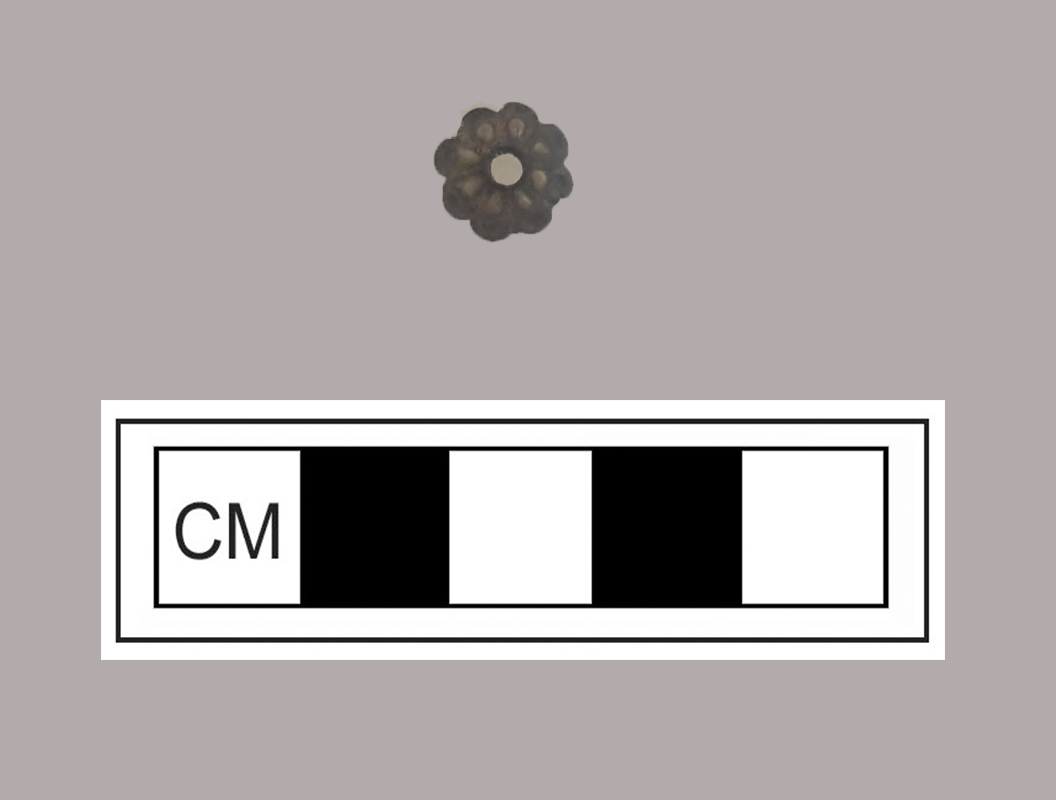
Metal Relic
- Cast
- Probably 17th century
This is a gold-plated ornament that may have been part of a rosary. A similar artifact was recovered at Mission San Juan del Puerto on the east coast of Florida. That piece was at the base of a rosary bead. A chain or string would have run through the perforation in the ornament as well as through the bead.

Adze
- Flaked stone
- Mississippian to Historic
Native Americans traditionally relied upon stone tools for a wide variety of everyday tasks that we usually associate with metal implements: spear points and arrowheads, knives, axes, drills, and so on. This adze was a wood-working tool, flat on one side and “humped” on the other. The humped side may have been shaped this way to make the adze easier to grasp. The edge then could be pushed along a piece of wood to plane off and smooth irregularities on the wood’s surface. On missions and other Native American sites of the colonial era it is common to find both stone and introduced European metal tools.
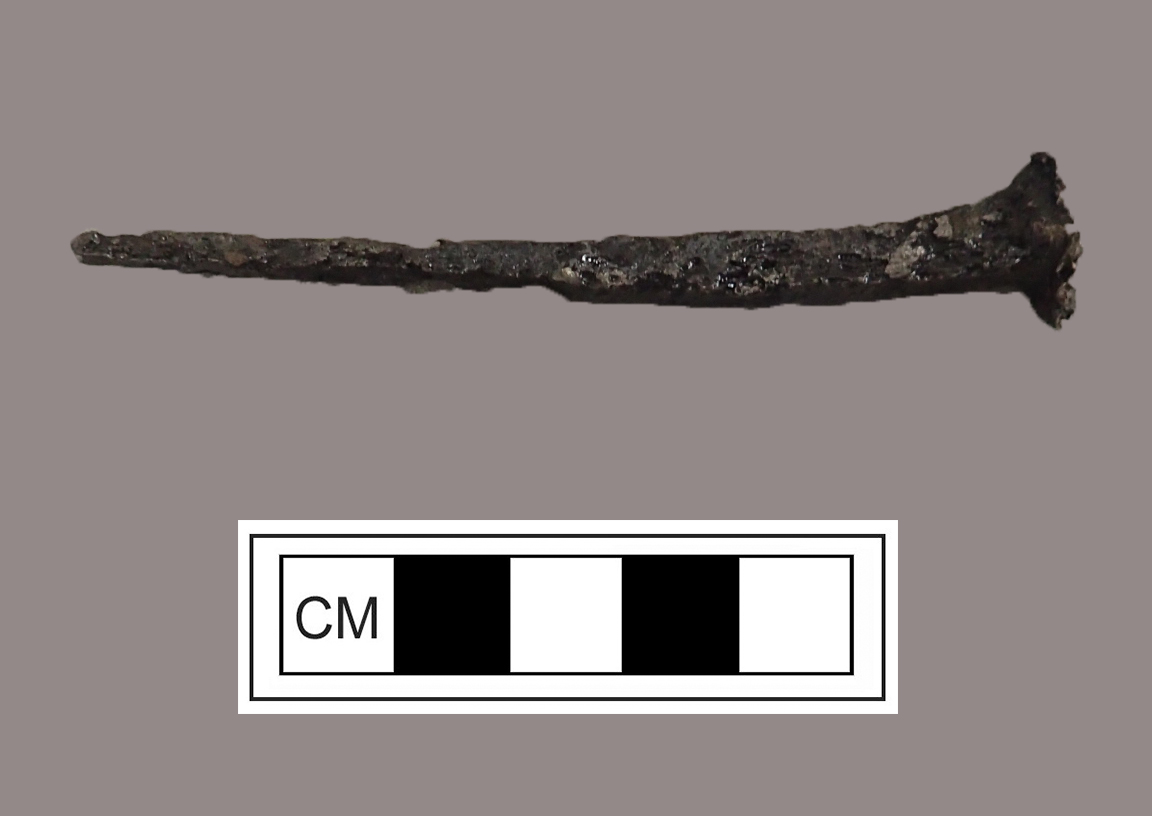
Iron Nail
- Hand forged
- 1400s to early 1800s
Hand forged nails are commonplace on colonial sites that contain European architecture. On mission sites, clusters of iron nails usually indicate the locations of buildings erected by the missionaries, such as the church, kitchen outbuilding, or the missionary living quarters.
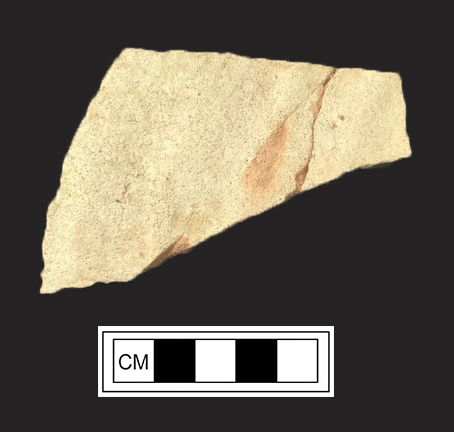
Spanish Olive Jar (fragment)
- Wheel thrown
- 1400s to 1800s
- Spain
Olive jars were the primary storage and shipping containers for the Spanish American colonies. These amphora-shaped, coarse earthenware vessels are usually associated with the transport of liquids related to food preparation or consumption, such as olive oil and wine. However, olives, pitch and other foods and substances have also been identified in them. Olive jars evolved in shape and manufacturing technique through time. For example, early types may have a green glaze on the interior surface.

Ichetucknee Point
- Flaked stone
- Mississippian to Historic
These small, lanceolate points are believed to have been used to tip arrows. Lanceolate point traditions are common in the Mississippian (AD 1000-1500) to early colonial (1500-1600s) Native American cultures of southeastern North America, but they are distinguished by regional variations in shape and manufacturing techniques. The Ichetucknee Point, mainly found in central Florida, is characterized by sides that flare slightly outward.
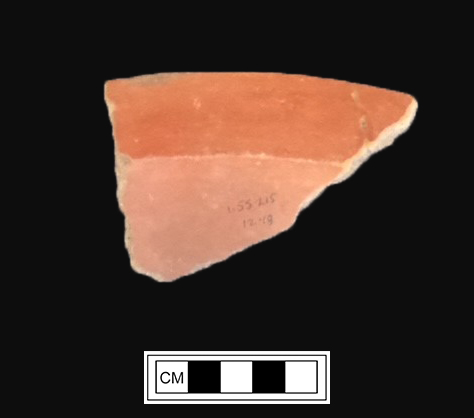
Colonoware
- Handbuilt coil
- Mission period, ca. 1587-1700
During the colonial period Native Americans sometimes crafted pottery using traditional manufacturing methods, but in European vessel forms. These are known as colonowares. This Mission Red Filmed colonoware sherd was part of a Spanish brimmed plato form. It is likely that a Native American made it to be used by Spanish friars at the mission site.

Carved bone utensil handle
- Hand carved
- 16th to 17th century
Carved bone utensil handle, most likely used by a friar at Mission San Juan del Puerto.
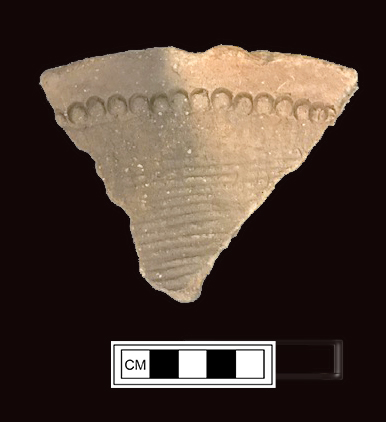
San Marcos Stamped and Punctated
- Handbuilt coil
- Mission period, ca. 1587-1700
San Marcos Stamped and Punctated ceramic sherd recovered from Mission San Juan del Puerto.
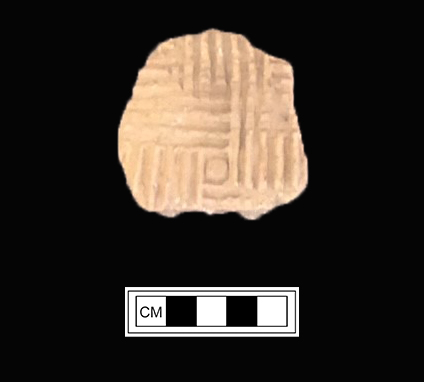
San Marcos Pottery
- Handbuilt coil
- Mission period, ca. 1587-1700
San Marcos Line Block Stamped ceramic sherd recovered from Mission San Juan del Puerto.
